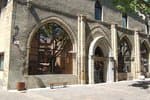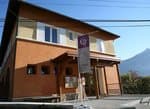Lac de Serre-Ponçon 4-day Electric Mountain Bike Tour
4 steps
16 points of interest
 Flora
FloraWhite Birch
This is a beautiful tree that can reach 15 m in height. Its leaves can be identified by the white tomentose down on the underside. Its white flowers are grouped together in an inflorescence and bud fruit called "alises", which appear at the end of summer. This species likes a lot of light and tolerates dry conditions well. It can be found in open woods and on sunny, even rocky, dry slopes in the mountains.
. Fauna
FaunaZygaena hilaris
This is a medium-sized butterfly (25-35 mm wingspan), often brightly coloured, with up to six spots on the inner wing. This Burnet is found on the edges of limestone meadows, steppe-like slopes, dry shrublands and clearings in dry forests. This remarkable species is indicative of the quality of the habitats. It is not nevertheless endangered, which is why it is not on the list of threatened species. Panorama
PanoramaL'Avance Lookout
Learn the names of the different peaks in the Valley of l'Avance! Water
WaterAddos mountain stream
The Addos mountain stream (torrent in French) is 4 kilometres long. A mountain stream is a natural water course located in the mountains. The flow regime is characterised by a steep gradient, with a very fast and therefore turbulent water flow producing significant erosion. It is also defined by a significant variation in flow rate depending on precipitation levels. In this mountain stream, as in many others, numerous small sills (small dams) have been created to slow down the water flow and limit the impact of floods. Fauna
FaunaCommon magpie
This bird can be identified by its black and white plumage with blue-green tints on the wings and tail. Its tail is remarkably long. It can be found all year round in varied open environments. Its omnivorous diet consists of invertebrates, seeds and berries, small rodents, eggs and nestlings and even human rubbish. Except during the nesting period when it is solitary, the magpie is gregarious species which gathers into rather raucous groups in the winter. Flora
FloraCommon juniper
This bush is a resinous evergreen conifer. It is characterised by its greenish to blue (glaucous) needles with a white line on their upper side, and fruits resembling blue-black berries. It usually tends to grow in warm environments receiving plenty of sunlight. It grows in grassy or scrub covered areas up to 2,000 metres above sea level. Fauna
FaunaThe field cricket
Just 18 to 26 mm long, this little insect has a black head which looks a little like a helmet. The female can be told apart from the male by the presence of a third long appendage at the rear of the body. The cricket’s song is heard from April onwards. The male sings his chirping song from the entrance to his burrow. The fertile females lay their eggs in the ground, which remain there for two weeks before the larvae emerge. Flora
FloraMessicole plants
A feature of messicole plants is that they live among crops, even though not sown there deliberately. They are biologically adapted to open areas, and in particular areas that are regularly worked, such as fields. In fact, they use various strategies such as adapting their life cycle and producing large amounts of seeds in order to make up for the disturbance that occurs in their germination area. Many of them are common, such as the poppy, the cornflower and the corn buttercup... Panorama
PanoramaPanorama of the Baie Saint-Michel
This area, which has been provided with picnic amenities, offers the most picturesque panorama over the Lac de Serre-Ponçon. In fact, the lake is 2 kilometres wide at this point, and in front of you are the Chapelle Saint Michel and the Pic Morgon, an iconic view of the lake. On your left, to the east, you can see Savines-le-Lac and its bridge. On the right, you can see the secret île de la Tortue. Fauna
FaunaThe Occellated Lizard
This shy lizard is familiar with dry, scrubby environments. It is hard to track down and flees noisily at the slightest danger. It can run very fast, standing up on its legs with its tail raised. Its burrow serves as a refuge and hibernation site, as it is particularly sensitive to the cold. It devours whatever it can find: insects, fruit, molluscs, eggs; small mammals can even be on the menu. It has blue eye-spots on its flanks.
 Fauna
FaunaGreat Cormorant
Size: 90 cm
 Fauna
FaunaYellow-legged Gull
It has travelled up the Durance and settled on the lake, where it finds propitious conditions for its survival (open water). This gull, a cousin of the seagulls, is omnivorous. The colony can be seen around the lake all year round. They are generally grey or white, with black markings on the wings. They have a long, thick beak and yellow webbed feet. The young are grey in colour and take two to four years to acquire adult plumage. Fauna
FaunaGrass Carp
This fish takes its French name (Amour Blanc) from the river it originates in, the “Amur” River, which forms the border between China and Siberia. Its powerful body resembles that of the carp, but its low-set eyes are very different. The well-thought-out and reversible introduction of this species by the town of Embrun and the fishermen is a gentle, ecological and controlled way of solving the problem of plant proliferation in the Embrun water body. Fauna
FaunaMallard
Not known to be shy, this dabbler prefers to feed on the surface or at shallow depths by moving forward with alternating circular strokes of its legs: it dips its head into the water and tilts forward. It nests on the banks of the Durance and is omnivorous, feeding on invertebrates, small fish and grasses... The male is easily recognisable during the breeding season by its bright green head. After this period, they moult and adopt a grey-brown colour close to that of the females and young.
 Fauna
FaunaThe fry
This is one of the most common 'white' fish. It has a spindle-shaped body, compressed laterally and covered with large silvery scales. Its lower fins and eyes are tinted red. Opportunistic, it eats both plants and tiny prey such as larvae and mosquitoes. It forms large shoals and most of the lake's anglers take their first steps on the water by catching them. Fauna
FaunaCommon Perch
The Perch has a grey-green body with dark stripes. Its scales are rough. It has two dorsal fins, one of which has spiny rays. Its lower and caudal fins are orange. It can grow to around forty centimetres. It is a gregarious and opportunistic carnivore. It feeds on invertebrates and crayfish, but also hunts fish in organised packs. It is a chance for many novice anglers to get their first taste of carnivorous fishing.
.
Description
Day 2: The route follows ridable ascents on tracks and fabulous wooded descents, all off the beaten track. You then return to the lake shore, with the possibility of bathing at the Ubaye cemetery. The route then runs along an old railway line. The day's final section runs through terrain where the landscape opens out onto hills dotted with welcoming hamlets and villages.
Day 3: The explanation for the existence of the lake: the dam. After passing the belvedere of L'Escoubaye and riding down a fabulous trail, at a junction with the road you can head for the dam belvedere. The route rounds the peak of La Viste and on to the Colombis mountain. The "Ruban" is a must-ride mountain biking trail in this sector. A ridge trail offers a stunning panoramic view over the lake and a winding descent down to the Col Lesbraut. From the col, the route becomes more technical until you reach the lake shore: some steep slopes before heading directly downhill on a Provençal trail and coming to Chorges along fast tracks.
Day 4: From Chorges, you return to the lake shore. The tone is set! Uphill and downhill, you pass from bays to inlets along a succession of ridable paths and bracing trails, sometimes facing the lake, sometime Mont Guillaume. The second part of the day takes you to the belvedere of Le Pibou. From this viewing point, you can see your route over the last three days. The Descente du Tourniquet will be your finale! This is a classic in the Embrunais, a trail running down to the lake shore in a succession of bends. Crossing the dam takes you back to welcome tranquillity to round this day off.
- Towns crossed : Baratier, Crots, Savines-le-Lac, Pontis, Le Lauzet-Ubaye, Rousset, Espinasses, Chorges, Prunières, Saint-Apollinaire, Puy-Sanières, and Embrun
Altimetric profile
Recommandations
Book your accommodation. A trip organiser and mountain bike instructor will simplify your organisation and make your trip so much more enjoyable, as well as saving you time.
Information desks
Tourist office Chorges
Grand rue, 05230 Chorges
October to may : Monday to Saturday, 9.00 - 12.30 & 13.30 - 17.00.
April, may, june & september : Monday to Saturday, 9.00 - 12.30 & 14.30 - 18.00
July and August : Monday to Saturday, 9:00 – 12.30 & 14.30 – 19.00 Sunday 9.30 – 12.30
Closed on Thursdays outside French holidays’ periods
Closed on French national holidays, except 14th of July and 15th of August
Tourist office Savines-le-Lac
9 Avenue de la Combe d'Or, 05160 Savines-le-Lac
October to march : Monday to Saturday, 9.00 - 12.30 & 13.30 - 17.00.
April, may, june & september : Monday to Saturday, 9.00 - 12.30 & 14.30 - 18.00
July and August : Monday to Saturday, 9.00 - 13.00 & 15.00 - 19.00. Sundays, 10.00 - 13.00 & 15.00 - 18.00
Closed on French national holidays, except 14th of July, and 15th of August
Closed on Thursdays outside French holidays’ periods
Tourist office Embrun
Place Général Dosse - BP 49, 05202 Embrun
October to march : Monday to Saturday, 9.00 - 12.30 & 13.30 - 17.00.
April, may, june & september : Monday to Saturday, 9.00 - 12.30 & 14.30 - 18.00
July and August : Monday to Saturday, 9.00 - 19.00. Sundays, 10.00 - 12.30 & 16.00 - 19.00
On French national holidays (except 14th of July and 15th of August) : 9am to 1pm. Closed on the 1st of January, 1st of May, 25th December and 11th November
Closed on Thursdays outside French holidays’ periods
Maison du Parc de l'Embrunais
Place de l’Église, 05380 Châteauroux-les-Alpes
Information, documentation, exhibition, screenings, products and books of the Park. Accessible to people with reduced mobility. Free admission. All animations of the Park are free unless otherwise stated.
Transport
TGV to Grenoble, Valence, Aix en Provence.
Booking information and ticketing: https://www.oui.sncf/
TER PACA (Provence Alpes-Côte-d'Azur) regional rail routes – Chorges railway station or Embrun railway station www.ter.sncf.com/paca
Access and parking
Source

Report a problem or an error
If you have found an error on this page or if you have noticed any problems during your hike, please report them to us here:



